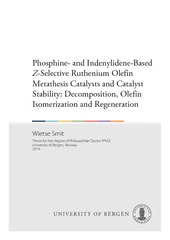| dc.description.abstract | This thesis describes the development and synthesis of phosphine-bearing first-generation Z-selective olefin metathesis catalysts that give 70–95% of the Z-isomer product in homocoupling of terminal alkenes such as allylbenzene, 1-octene, allyl acetate, and 2-allyloxyethanol. Density functional theory (DFT) calculations revealed the importance of sufficient steric interaction between the PR3 ligand and the bulky 2,4,6-triphenylbenzenethiolate and showed that limiting rotation around the P–Ru bond with chelating anionic phosphine ligands such as o-(ditert-butylphosphino)phenolate improves Z-selectivity. The most prolific catalyst, [P(–6-O–C6H4)(tBu)2](–S–2,4,6–Ph–C6H2)Ru(=CH–o–OiPrC6H4) (37), performs homocoupling metathesis with Z-selectivity > 80% with internal olefins such as 1-octene and allylbenzene, and > 90% with allylacetate. In addition, while the catalysts described here are somewhat less active compared to their N-heterocyclic carbene (NHC) bearing second-generation counterparts, they show less substrate and product isomerization and thus higher yields. The strategy described above was extended to prepare the first Z-selective indenylidene-bearing ruthenium catalysts RuCl(NHC)(–S–2,4,6–Ph–C6H2)(Py)(3-phenylindenylidene (NHC = IMes = 1,3-bis(2,4,6-trimethylphenyl)imidazol-2-ylidene (40) or SIMes = 1,3-bis(2,4,6-trimethylphenyl)-4,5-dihydroimidazol-2-ylidene (42)). Together with showing Z-selectivity, these catalysts were envisaged to combine two additional desirable properties: improved thermal stability, via substitution of the traditional benzylidene moiety for 3-phenylindenylidene; and fast initiation of olefin metathesis, by using pyridine as stabilizing donor ligand. Interestingly, the molecular structures obtained from X-ray diffraction show that steric pressure resulting from the three bulky ligands (the NHC, the arylthiolate, and the indenylidene) forces the thiolate ligand to position itself trans to the NHC ligand, a configuration thought as being incompatible with Z-selectivity or high catalytic activity. To our surprise, these new complexes turn out to initiate rapidly, even at room temperature. Furthermore, they offer up to 80% Z-selectivity in homocoupling of a range of 1-alkenes and are relatively stable in catalysis (TONs up to 2200). Unfortunately, despite the presence of the indenylidene ligand, thermal stability is rather poor. DFT calculations show that pyridine dissociates easily, explaining the fast initiating character. Furthermore, the 14-electron complex, obtained after pyridine dissociation, isomerizes to yield the active species; in here, the thiolate is, analogue to other monothiolate-based Z-selective catalysts, found trans w.r.t. to Cl. Catalyst decomposition, to species that promote double-bond migration of the substrate and product, is responsible for undesired by-products observed in metathesis experiments. Although this is an important problem, the pathways that lead to catalyst decomposition are not well understood, especially those that originate in intermediates of the olefin metathesis catalytic cycle. Here, using DFT calculations, the Hoveyda–Grubbs second-generation catalyst was decomposed with allylbenzene via ring expansion of the metallacyclobutane intermediate. This facile decomposition pathway leads to loss of the alkylidene ligand and formation of spin-triplet 12-electron complex (SIMes)RuCl2 (3R21). DFT calculations predicted this to be a key species to double-bond migration: upon direct reaction with the substrate, the η3-allyl mechanism is entered, while spin inversion to R21, followed by formation of a cyclometalated Ru-hydride complex, activates the hydride mechanism. Synthesis of p-cymene-stabilized R21 (44) allowed for experimental confirmation of the computational predictions. Catalytic testing showed that, under conditions that promote dissociation of p-cymene, alkene isomerization is favoured. Furthermore, trends in the selectivities towards metathesis and isomerization are shared between Hoveyda–Grubbs second-generation catalyst and 44, indicating that the same reaction network applies to both of them. The loss of the alkylidene moiety was presumed to be irreversible; yet, when alkylidene-free 44 or its congeners are reacted with olefins, metathesis products are observed. With the alkylidene being a prerequisite to perform olefin metathesis, in situ regeneration is implied. DFT calculations suggest dinuclear ruthenium activation of alkene as a viable pathway. Moreover, we experimentally prove that ruthenium alkylidenes can be generated from 44 and catalyst poison ethene. | en_US |
| dc.relation.haspart | Paper II: “Loss and Reformation of Ruthenium Alkylidene: Connecting Olefin Metathesis, Catalyst Deactivation, Regeneration, and Isomerization”. Julien Engel, Wietse Smit, Marco Foscato, Giovanni Occhipinti, Karl W. T¨ornroos, and Vidar R. Jensen. Journal of the American Chemical Society 2017, 139, 16609–16619. The article is available at: <a href="http://hdl.handle.net/1956/18137" target="blank">http://hdl.handle.net/1956/18137</a> | en_US |
